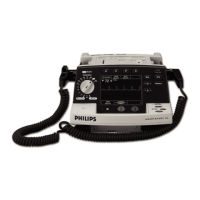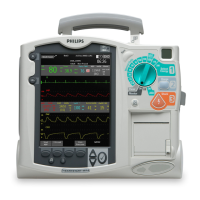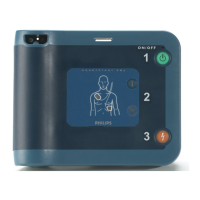M4735A Service Manual 6-11
System Functional Descriptions
6
Pacing Functions
Pacing is initiated and controlled by pressing front panel keys. These key
presses are transferred from the keys to the Keyscan PCA via a flex circuit.
The key presses are detected and processed by the Keyscan PCA and then
passed to the Control PCA via a large ribbon cable.
The Control PCA directs the Power PCA to deliver the pacing pulses at the
rate and output current selected by the user. The pacing pulses are delivered
via the pads cable to the defibrillation pads. The pacing current delivered is
reported back to the Control PCA, which sends the info to the display and
activates any printouts or screen messages as needed.
Audio Functions
The M4735A has two types of audio output: tones, and voice prompts. Both
are generated and controlled by the Control PCA, which also amplifies the
signals and passes them directly to the speaker via a dedicated connector and
wire pair.
Display Functions
All display functions are handled by the Control PCA. Display formats,
graphics, waveforms, numeric values, and messages are all generated and
formatted by the Control PCA, using either data it has or data it receives from
other parts of the unit.
Indicator Functions
All front panel LEDs (Sync, Pacer, AC Power and Batt Charge) are controlled by
the Control PCA. The LEDs are connected into the Keyscan PCA via flex
circuits; they are then routed to the Control PCA via a ribbon cable.
Key Functions
All keys, both on the Main Keypad and on the Pacer Keypad, connect to the
Keyscan PCA via flex circuits. Keypresses from all keys are detected and
processed by the Keyscan PCA and then passed to the Control PCA via a
large ribbon cable. The Control PCA then interacts with the other parts of the
system as needed to respond to the keypress.

